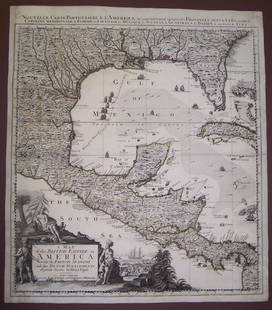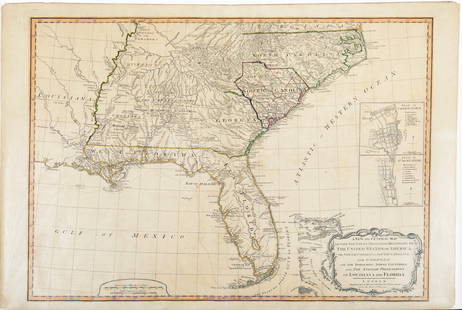
Map of Khartoum 20 Years After Gordon's Death Annotated & Signed by Current British Gov.: Landmarks
Similar Sale History
View More Items in Maps & AtlasesRelated Maps & Atlases
More Items in British Maps & Atlases
View MoreRecommended Transportation & Travel Collectibles
View More









Item Details
Description
A fascinating item sure to interest collectors of British Imperial history, African history, military history, art history, and cartography alike!
A printed map of "Khartoum City" has been inscribed with over 20 words and signed by Lieutenant-Colonel Edward Alexander Stanton (1867-1947), then Governor of Khartoum, as: "Route for carriage - / 9.30 AM Monday Feb 6th / out to Gordon College. / back through Town / E.A. Stanton / 29.1.05 / Gov. Ktm - Pr Miralar (?)" Either Stanton or a clerk has carefully marked out proposed routes in red and blue colored pencil on the map above. A bold blue hand-stamp in both English and Arabic, dated "20 Oct 1904" and reading in part "Mudir's Office / Khartoum Muderieh," appears at lower left. Expected wear includes paper folds, some split and repaired verso, as well as a few isolated chips or closed tears. A ghost impression of the Mudir's Office stamp can be seen at lower right, touching the reference index. Pencil inscribed verso. Else near fine. 15.125" x 11.875." Easily deserving of hours of additional research! Ex-Forbes Collection.
Stanton's predecessor, Major-General Charles "Chinese" Gordon (1833-1885), may have been dead for 20 years in 1905, but he was still on everyone's mind. Gordon had served two non-consecutive terms as Governor-General of the Sudan, the last term ending with his death during the Siege of Khartoum. Gordon had been killed by Mahdist forces (followers of Muhammad Ahmad, a Muslim messianic leader) on January 26, 1885. Gordon's death shocked the entire British Empire and the loss of Khartoum was a great blow to imperial prestige. The city was retaken from the Dervishes by British forces commanded by Sir Herbert Kitchener in 1898. It was a bittersweet victory reclaiming the city where so many had died: it is estimated that approximately 10,000 civilians and British garrison soldiers were killed during the January 1885 raid.
Who was invited to Stanton's February 6, 1905 carriage ride around Khartoum City? It is unclear. The 20th anniversary of Gordon's murder had taken place just three days before Stanton's inscription was dated, so it is possible that the city tour--culminating in a visit to Gordon Memorial College--could have been some sort of commemorative exercise. If that is not the case, we can assume that Stanton's carriage ride was planned for a special guest or visitor.
The map shows the new city of Khartoum as conceived by Sir Herbert Kitchener, ca. 1899. Much of the city was in ruins in 1898, and Kitchener used this as an opportunity to redesign Khartoum as a flagship example of British colonial urban planning. He razed many of the structures with the exception of important buildings, and kept the historic palm groves, but streets and squares were recharted in neat, geometric lines. Kitchener's new Khartoum prioritized orderliness, cleanliness, and defensive potential; never again would forces be able to easily retake the city.
Gordon's legacy could be seen all around the new Khartoum. Some of the important landmarks visible on the map include:
1. The Governor-General's Palace, alternately called the Palace or the Regiment House, where it is believed Gordon had been cut down on a staircase before being beheaded. This is marked as No. 13 of the reference panel, listed as "The Palace." The u-shaped structure had been rebuilt, but it was still in its prominent position overlooking the Blue Nile.
2. "Gordon's Statue" was located on Khedive Avenue just steps away from the Palace in the Public Gardens. The bronze sculpture of Gordon seated cross-legged upon a Sudanese camel was designed by the British sculptor Edward Onslow Ford (1852-1901). Gordon's supporters had contributed to a subscription fund so that a replica of Ford's sculpture of Gordon already displayed at Brompton Barracks in Chatham could be erected near Gordon's actual place of death. The second cast was transported from England to Khartoum via Alexandria in 1902; the Gordon statue stood in the city until 1958, when it was removed during the Sudanese independence movement. It can still be seen today on the campus of Gordon's School at Woking, Surrey (it was relocated there in 1959).
3. Gordon Memorial College, shown on the map as the first item on the reference panel, as "Gordon College." Kitchener was instrumental in the construction, between 1899-1902, of Gordon Memorial College, located to the far east of Khedive Avenue near a set of British Barracks. The College has educated many different types of students--ranging from primary school age to those seeking advanced degrees--over the course of its history. It is now known as the University of Khartoum.
Edward Alexander Stanton, the son of British Army officer Edward Stanton, had been educated at Marlborough and Sandhurst. E.A. Stanton joined the infantry in 1887 and was promoted in 1894 and 1898 to captain and brevet-major. He participated in the Dongola, Atbara, Omdurman, and Nile Expedition campaigns with great distinction. Stanton served as Governor of Khartoum from 1900 to 1908, eventually being awarded a 2nd Class Medjidie and granted the rank of Pasha. He later served as military governor of Haifa in Palestine from 1918-1920.
Provenance: Ex-Forbes Collection. Malcolm Forbes (1919-1990), the American owner-publisher of Forbes magazine and a consummate collector, amassed one of the most substantial autograph collections of such breadth and depth that it filled a half-dozen residences on three continents. Many of his manuscripts were sold in a series of multi-million dollar sales by Christie's in the early 2000s. The Forbes name is considered to be the apex of provenance, especially when attached to an item like the above.
This item comes with a Certificate from John Reznikoff, a premier authenticator for both major 3rd party authentication services, PSA and JSA (James Spence Authentications), as well as numerous auction houses.
WE PROVIDE IN-HOUSE SHIPPING WORLDWIDE!
Buyer's Premium
- 25%
Map of Khartoum 20 Years After Gordon's Death Annotated & Signed by Current British Gov.: Landmarks
Shipping & Pickup Options
Item located in Wilton, CT, usPayment

Auction Curated By



























![Des Barres Map of NY Harbor: *** START PRICE IS THE RESERVE *** [America] DES BARRES, Joseph Frederick Wallet (1729-1824). A Chart of New York Harbour with the Soundings Views of Land Marks and Nautical directions for the Use of](https://p1.liveauctioneers.com/1968/163248/82424572_1_x.jpg?height=310&quality=70&version=1583340284)












































